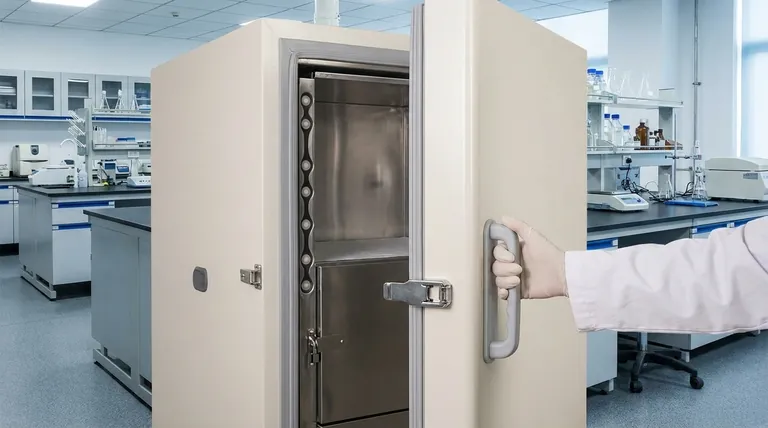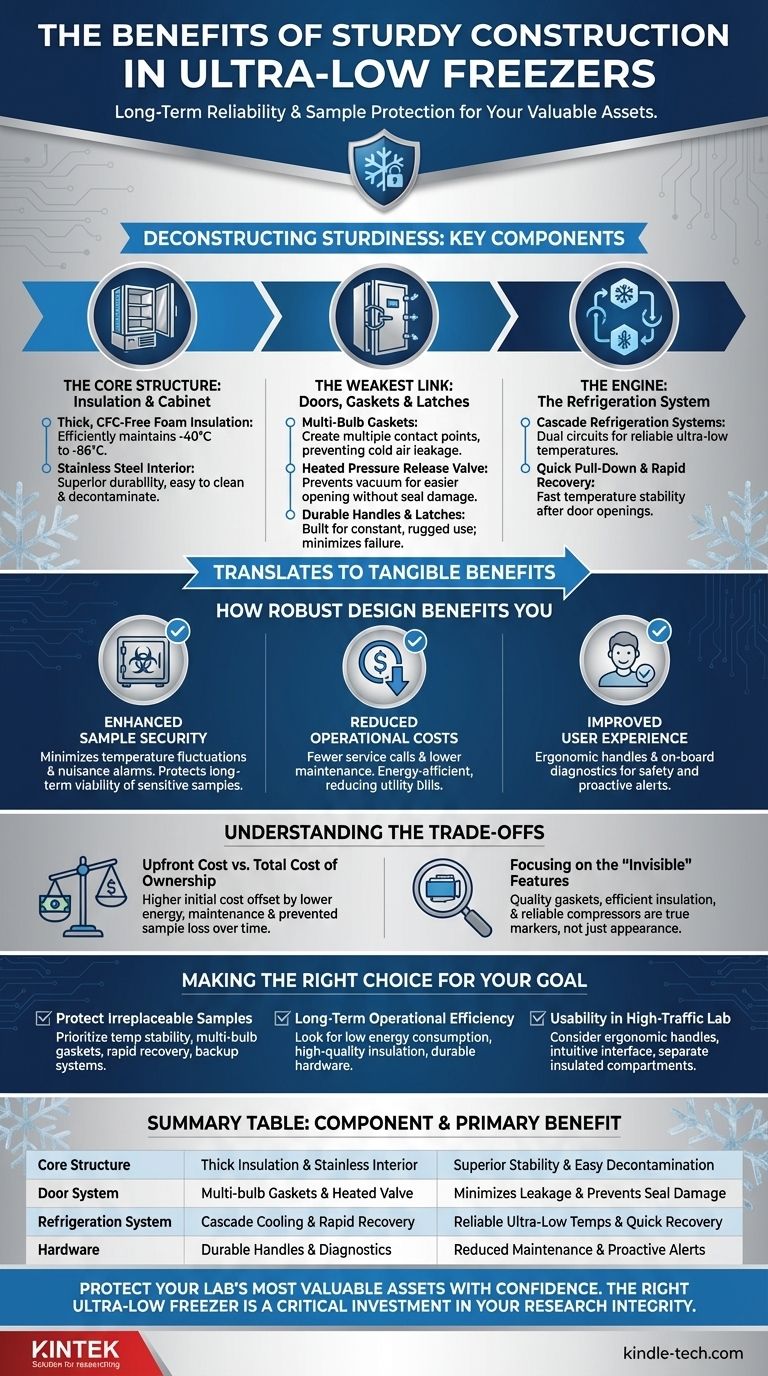In short, sturdy construction in an ultra-low freezer delivers long-term reliability and protects your valuable samples. A robust build, from the door handles to the internal systems, ensures the unit can withstand the demands of a busy lab environment, which reduces maintenance needs, minimizes downtime, and maintains critical temperature stability.
The concept of "sturdy construction" goes beyond a strong metal box. It represents an integrated system of durable components—insulation, seals, and hardware—all working together to achieve the primary goal: creating an unwavering, ultra-low temperature environment to guarantee the integrity of its contents.

Deconstructing Sturdiness: Key Components of a Reliable Freezer
A freezer's reliability is determined by the quality of its individual parts and how they function together. Weakness in one area can compromise the entire system.
The Core Structure: Insulation and Cabinet
The foundation of a good freezer is its ability to isolate the internal environment. This relies on thick, high-quality insulation, typically CFC-free foam, which is essential for maintaining extreme temperatures between -40°C and -86°C efficiently.
The interior is just as important. Stainless steel interiors are a hallmark of sturdy construction, offering superior durability and being far easier to clean and decontaminate than plastic.
The Weakest Link: Doors, Gaskets, and Latches
The door is the most frequently used part of the freezer and the primary source of temperature fluctuations. Sturdy construction here is non-negotiable.
Features like multi-bulb gaskets create multiple points of contact, ensuring a tighter seal to prevent cold air leakage. A heated pressure release valve prevents the vacuum that can form at ultra-low temperatures, making the door easier to open without damaging the seal.
Finally, durable door handles and latches are built to withstand constant, rugged use, preventing the most common points of mechanical failure.
The Engine: The Refrigeration System
The internal mechanics are a critical part of a freezer's robust design. Cascade refrigeration systems, which use two interdependent cooling circuits, are the industry standard for reaching and maintaining ultra-low temperatures reliably.
This system is responsible for critical performance metrics like quick temperature pull-down (getting to the set temperature quickly) and rapid recovery after a door opening.
How Robust Design Translates to Tangible Benefits
Focusing on construction quality directly impacts your daily operations, budget, and peace of mind.
Enhanced Sample Security
The ultimate benefit of a sturdy freezer is the protection of its contents. A tightly sealed door with excellent insulation minimizes temperature fluctuations, which is critical for the long-term viability of sensitive biological samples.
Fast temperature recovery after a door opening means samples spend less time exposed to stressful temperature changes, and it reduces the likelihood of nuisance alarms during daily use.
Reduced Operational Costs
A well-constructed freezer is an investment that pays off over time. Durable components mean fewer service calls and lower maintenance costs.
More importantly, a unit with superior insulation and tight seals is more energy-efficient, as the cooling system doesn't have to work as hard to maintain its setpoint.
Improved User Experience
Sturdy construction often includes ergonomic features that make the freezer easier and safer to use. This includes smart handles that are easier to operate and on-board system diagnostics that alert users to potential issues before they become critical failures.
Understanding the Trade-offs
While the benefits are clear, it's important to approach your decision with a complete picture.
Upfront Cost vs. Total Cost of Ownership
Freezers with verifiably sturdy construction and premium components almost always have a higher initial purchase price. However, this cost is often offset over the freezer's lifespan by lower energy bills, reduced maintenance needs, and, most critically, the prevention of catastrophic sample loss.
Focusing on the "Invisible" Features
It's easy to be impressed by a heavy-gauge steel cabinet, but the true markers of sturdiness are often less visible. The quality of the gaskets, the efficiency of the insulation, and the reliability of the compressors are what truly dictate long-term performance. A cheaper unit may look robust but fail in these critical areas.
Making the Right Choice for Your Goal
Selecting a freezer requires matching its construction features to your lab's primary needs.
- If your primary focus is protecting irreplaceable samples: Prioritize units with the best temperature stability features, such as multi-bulb gaskets, rapid temperature recovery rates, and robust backup systems (LN2 or CO2).
- If your primary focus is long-term operational efficiency: Look for documented low energy consumption, high-quality insulation, and durable components like heavy-duty door latches and handles to minimize the total cost of ownership.
- If your primary focus is usability in a high-traffic lab: Consider ergonomic features like easy-open handles, an intuitive user interface, and an interior design with separate, insulated compartments to reduce temperature loss during access.
Ultimately, a well-constructed ultra-low freezer is not an expense but a fundamental investment in the integrity and security of your work.
Summary Table:
| Component | Key Feature | Primary Benefit |
|---|---|---|
| Core Structure | Thick, CFC-free foam insulation & stainless steel interior | Superior temperature stability & easy decontamination |
| Door System | Multi-bulb gaskets & heated pressure release valve | Minimizes cold air leakage & prevents seal damage |
| Refrigeration System | Cascade cooling & rapid temperature recovery | Reliable ultra-low temperatures & quick recovery after door openings |
| Hardware | Durable handles, latches, and on-board diagnostics | Reduced maintenance needs & proactive issue alerts |
Protect your lab's most valuable assets with confidence. The right ultra-low freezer is a critical investment in your research integrity. At KINTEK, we specialize in high-performance lab equipment designed for durability, efficiency, and sample security. Let our experts help you select a freezer that meets your specific needs for temperature stability, energy savings, and long-term reliability. Contact KINTEK today to find the perfect ultra-low freezer for your laboratory.
Visual Guide

Related Products
- 408L Advanced Vertical Laboratory Ultra Low Temperature Freezer for Critical Research Material Preservation
- 108L Vertical Ultra Low Temperature ULT Freezer
- 508L Advanced Vertical Ultra Low Temperature Freezer for Critical Laboratory Storage
- 708L Ultra Low Temperature Freezer High Performance Laboratory Freezer
- 208L Advanced Precision Laboratory Ultra Low Temperature Freezer for Cold Storage
People Also Ask
- What are the common designs of ultra-low temperature freezers? Upright vs. Chest Models for Your Lab
- How do Ultra-Low Temperature freezers ensure the integrity of microbiological samples? Maintain Stability for Critical Research
- What are ultra low temperature freezers used for? Preserving Critical Biological Samples for Decades
- Where are ultra low temperature freezers commonly used? Essential for Labs, Hospitals, and Biotech
- In what fields are ultra low temperature freezers most commonly used? Essential for Biomedical, Clinical, and Research Labs



















